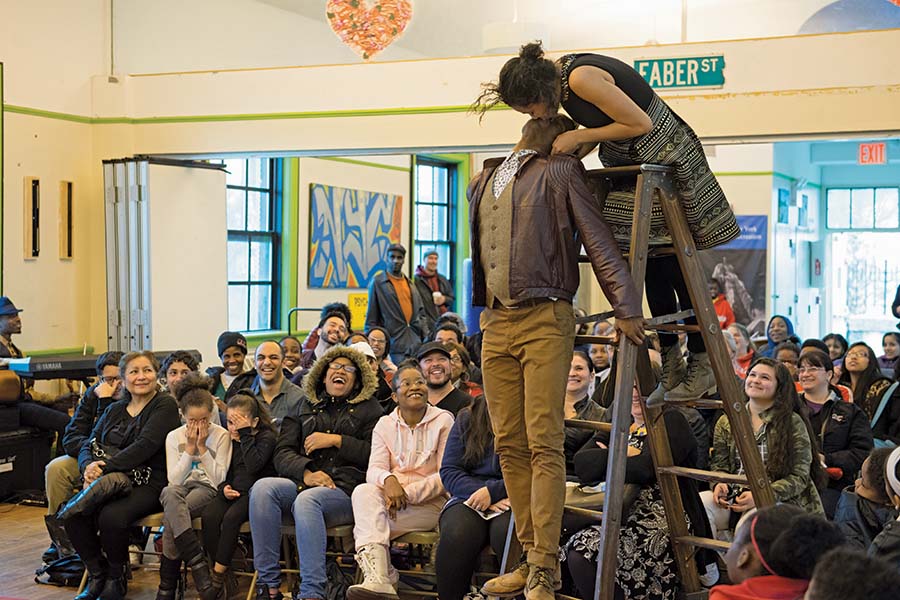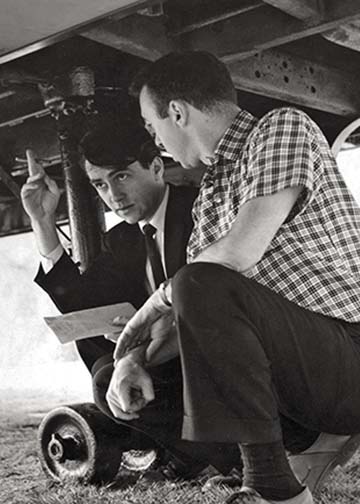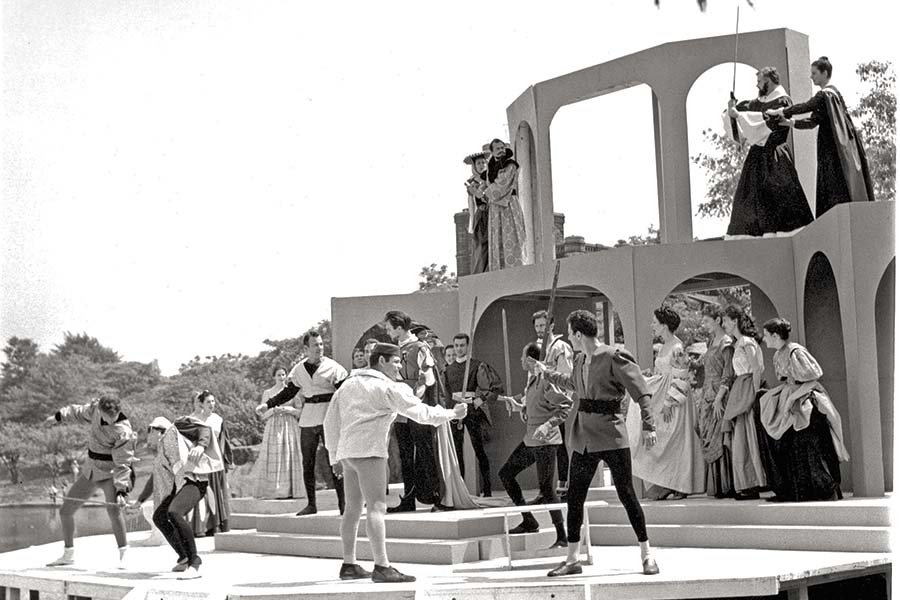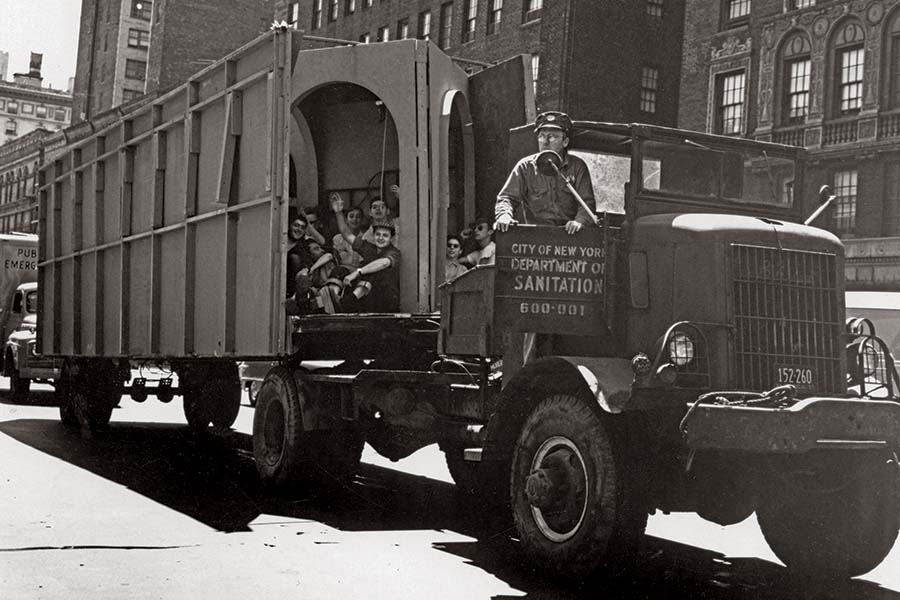Our destination was Rikers Island Correctional Facility, the spit of land just off the end of runway 13 at LaGuardia Airport, a place bizarrely accessed by a bleak, rusty bridge that cuts across New York City’s East River from the back of a dreary residential neighborhood.
On that February morning, an advance team of five people from the Public Theater pulled up to the check point in a Zipcar and a white van filled with props, a few benches, some odd balloon arrangements, a keyboard, and a 14-by-14-foot red carpet. It took 30 minutes to transport the stuff through the various levels of security, but within another 30 minutes, the facility’s gym was set up for a performance of the Mobile Unit’s Romeo and Juliet, directed by Lear deBessonet. The actors arrived shortly thereafter, in another white van, made their way through security, and changed into costumes in the old gym. Then the audience arrived—perhaps 65 inmates, and another 20 employees. The room was packed within minutes.
The most recent manifestation of the Mobile Unit may best be described as “poor theatre”—or, in the words of the Public’s artistic director, Oskar Eustis, “lean and mean” theatre. The intimate scale of the contemporary unit is quite different from the original sprawling conception of the Mobile Unit, which first took to the streets in the 1950s as NYC’s first touring theatre since the Federal Theatre in the 1930s. Based on a model developed and perfected by Michelle Hensley’s Minneapolis-based company Ten Thousand Things, the Public’s current Mobile Unit brings professional actors and directors together to perform the work of the Bard to underserved communities in New York. Requiring minimal space, a small ensemble of actors, and only a few set and prop pieces, this touring framework has a permeable quality: It can be successfully arranged in almost any space designed for public gatherings.
Barry Edelstein was a key player in reviving the Mobile Unit in 2010 after the program’s 30-year hiatus. Edelstein, now artistic director of the Old Globe in San Diego, describes his first revelatory encounter with Hensley’s work.
“I went to Minneapolis to see what [Hensley] was doing, and it was clear that this model solved so many practical problems,” Edelstein says. “You could do it anywhere, it was low-tech, it wouldn’t represent a huge producing burden, etc.” That led the Public to bring Hensley to New York to direct Measure for Measure and effectively reboot the theatre’s dormant initiative in a new guise.
Since then the Public has deployed its new Mobile Unit to dozens of community sites across the five boroughs, partnering with city and state correctional facilities, community and recreation centers, and city shelters. Each tour involves three weeks visiting city venues, then “sit-downs” at the Public for an additional three weeks, where the show is seen by downtown audiences and critics alike. Over these six weeks, upwards of 3,000 New Yorkers engage with the work. Across the boroughs, audience demand for touring work has grown steadily alongside the fledgling program. Under the current leadership of Stephanie Ybarra, the Public’s director of special artistic projects, the unit increased its output from one annual tour to two in the 2014-2015 season.
In addition to expanding programming, Ybarra has been cultivating new directions for the Mobile Unit, departing from Shakespeare to commission new works and “born Mobile” material, as well as piloting Spanish-language programming in community sites across the city. Following the Romeo and Juliet tour last spring, Ybarra mounted staged readings of Pablo Neruda’s poetic adaption of the play in Spanish, Romeo y Julieta (directed by Jerry Ruiz) at a small cohort of community venues. In NYC, where individuals who identify as Hispanic and Latinx now account for 28.9 percent of the population, and Spanish speakers make up the majority (25 percent) of non-English speaking or bilingual households in the city, Ybarra’s decision to present work in Spanish is a bold move that signals her interest in programming responsively to a changing city and country.
The growing hunger for more of the Public’s Mobile Unit work in communities across the city has been met by an increase in community-based programming at the theatre. Also in the mix is deBessonet’s Public Works, a program launched in 2012 to engage communities in the outer boroughs in year-round theatre classes and community potlucks, culminating in a 200-person pageant production in Central Park each September at the end of the famous Shakespeare in the Park summer season; it’s a program that has now been adapted by theatre companies nationwide.
In total, this trio of programs represents an inside-out and outside-in approach to urban connectivity through theatre, creating a citywide community that acts both as collaborators on and audience for canonical and new work.

It is easy to imagine that the Public’s founder, Joseph Papp, would be pleased with all of the activity, since he planted the seeds of this community-centric development from the very beginning. This spring, the Public will celebrate the 60th anniversary of its inaugural mobile tour in 1957. To mark the occasion, the Mobile Unit will tour Twelfth Night, directed by Saheem Ali, beginning March 30. The originating mobile tour in ’57 was also a production of Romeo and Juliet, directed by Papp, with Bryarly Lee and Stephen Joyce in the title roles. The impulse for the Public to travel, then, is not new. In fact, you could say it is a fundamental value of the Public.
“I always felt that we should travel,” Papp told his biographer Kenneth Turan in Free for All, an oral history of the Public. “I wanted to bring Shakespeare to the people—that was the whole idea. I had to reach the thousands of people who lived and died in their neighborhoods.” From the outset, Papp was vocally protective of the excellence and professionalism of the work performed on the Mobile stage. When The New York Times refused to cover Mobile Unit performances, Papp took aim at what he saw as the snobbery of the critical establishment. To Papp, ignoring theatre performed in neighborhood parks seemed to arbitrarily enforce and police a distinction between professional and community-based theatre. He responded by issuing a call to arms in the playbills for the mobile tour. “Dear Audience Member,” a handbill distributed at early Mobile Unit performances read. “It is automatic that any play opening on Broadway, though it be the worst piece of junk, ineptly produced and cast, having no purpose other than to satisfy the egos of a number of people with money enough to pay for the expensive adventure—this play will be covered without question […]. We ask you to join with us to express your disappointment of this policy to the editor of The New York Times.” As was the case with so many of his battles, he generally got his way, and Times critic Arthur Gelb would become a major advocate for Papp’s initiatives.

That persistence served Papp well from the beginning; his ambitious touring plans received early support from city authorities. Stanley Lowell, then deputy mayor, was an early champion for free theatre and mobilized city resources and departments to support Papp’s local tour. The first Mobile Unit rolled up to performance venues across the city in borrowed Department of Sanitation vehicles with a wooden folding stage mounted to a truck bed and portable seating risers to accommodate 700 people per venue. The Parks Department permitted performances in local parks across all five boroughs. Financial backing from the New York Foundation, Astor Foundation, and others enabled the nascent theatre company to put their show on the road in those early days.
It would take another decade-plus for the Public to find its footing with the original Mobile Unit; the touring arm frequently went dark for a year or more in the 1960s as Papp launched the permanent home for free Shakespeare in the Park, the Delacorte Theater. In its heyday during the 1970s, the Mobile Unit was a vibrant platform for new work development, boasting massive reach in the neighborhoods of New York and hosting approximately 70,000 audience members per tour.
Laura Aden Packer, now executive director of the Howard Gilman Foundation, remembers her first encounter with the Mobile Unit at a basketball court in her Upper West Side neighborhood in 1971.
“One day this truck pulled up and started unloading all kinds of equipment onto the basketball court,” Packer recalls. “When we asked what was going on, they said they were going to be putting on a show that evening. We were all incredulous and wondered why they had selected our little slice of concrete to stage a musical. And what a musical it was! Raul Julia and Clifton Davis in The Two Gentlemen of Verona.” For Packer and her friends, the themes of the play were especially resonant: “With Julia being pregnant and Proteus being such a bastard and two-timing dog—well, that was a very familiar story for my friends and me.”
Packer’s experience of that first Mobile Unit performance stayed with her long after the show had packed up and moved on to the next tour stop: It sparked a lifelong love of theatre. “It totally changed my life. My friends and I started playing handball less and going to the theatre more. Before I left for college, the Public felt like a second home. And of course I went to every show that Raul Julia was in!”
Yet this was but a temporary flourishing. After a number of successful back-to-back seasons, the Mobile Unit shuttered at the end of the 1979 season. Steven Cohen, Papp’s associate producer and right-hand man, recalls that the company in the late ’70s chose to redirect its energy to its downtown theatre at Astor Place and to the Delacorte Theater in Central Park. “We had been presenting the Shakespeare plays in the community parks for many years and felt that we had accomplished that wonderful goal,” Cohen notes. With revenue from A Chorus Line beginning to flow into the Public, Papp and his collaborators were faced with an artistic and financial choice: invest in the potential of the Astor Place theatre as a home for new-play development, or invest in the Mobile Unit’s future by overhauling the aging fleet of trucks and equipment. Papp chose to focus the company’s resources on Astor Place and the Delacorte, and Mobile fell away.
But if the Mobile Unit’s early incarnations were short-lived, implicit in Papp’s commitment to a permanent mobile arm of the Public was an understanding that a “theatre for all New Yorkers” could only be possible if the Public made its work available to audiences in the boroughs—and that many of these audiences face significant economic, social, and geographic barriers to accessing the city’s enormous cultural wealth. Although the demographics of NYC neighborhoods have shifted significantly since Papp’s time, cultural inequities persist to this day. Today, 80 percent of the New York City population lives outside Manhattan—in Brooklyn, Queens, Staten Island, and the Bronx—yet a 2011 study shared that only 25 percent of the city’s cultural institutions are located outside Manhattan. The current Mobile Unit is one remedy to the lack of professionally produced theatre available to culturally under-resourced neighborhoods of NYC.
Ybarra works closely with partner organizations to identify sites with the greatest need and maintains a dialogue with community arts organizations and advocates to ensure that the Public’s work in the boroughs supplements and supports community-based theatre rather than supplants it. For instance, prior to the Unit’s Macbeth tour in 2015, the New York City Parks Department shared details of their Community Parks Initiative (CPI) with Ybarra. As part of that initiative, the Parks Department committed to revitalization efforts at parks in neighborhoods with higher-than-average concentrations of poverty. They invited the Mobile Unit to prioritize touring to venues in designated CPI zones, to animate these newly restored community facilities, and to rejuvenate the potential of these public spaces to act as a home for neighborhood connections and shared artistic experiences.
Post-show audience surveys give evidence that the plan worked. As one audience member put it after the Macbeth tour: “As wonderful as the show was, nothing beats watching the audience watch the play—to see them transported with the words, actors, and some beautiful music to a different realm.” The surveys revealed that almost half of audiences at these sites were experiencing live theatre for the first time, and in a venue close to home. In addition to making professional theatre more accessible locally, Ybarra notes that the Mobile Unit effectively addressed the current cultural moment: “The political divide right now is deep. The Mobile Unit is one way to explore our commonalities. It is a reminder that we are in this together, that we need to take care of each other, that we are one together.”
That statement was especially true that February morning at Rikers last year, where actors spent almost 30 minutes with the residents and employees before the show, talking and laughing, answering questions, discussing Shakespeare. They then created a professional theatre experience using just plastic chairs, a square of carpet, some balloons, and quick changes. There was no backstage.
Everyone could watch Capulet change into the Friar. But why would they? The communion between audience and performers was happening on that small stage in the middle of the aging gym. Nothing else existed. There were remarkable emotions. When Romeo and Juliet kissed for the first time, the younger audience members hollered and whistled. Here, as in other Mobile locations, standard rules of theatre decorum did not really apply and no one seemed to mind. Midway through, a group of about 20 inmates from another part of the jail came in and grabbed chairs and set them up next to the established audience.
Two weeks later, at St. Paul’s Chapel, the now legendary place of worship near Ground Zero, the same setup of the same play with the same actors began to unfold. All of the lights were up, way up—bright, non-theatrical, even glaring. Here again was Shakespeare, in a church, amid a huge crowd, wedged between the carpet and the masses of 9/11 tributes and memorials.
Another day, another borough. A frigid Saturday morning, in the midst of an ice storm, the white vans pulled up to a community center on Staten Island: Out came the same battered red carpet, balloons, and costumes, only this time for kids, their parents, and anyone else who happened to hear about the event. The actors and crew patiently waited for the morning community dance class to end, then went to work.

Years ago Eustis was asked by Empty Space founder M. Burke Walker, “Where can you be the most use?” It’s a question he recalls often, he says, because it fundamentally changed his outlook on theatre and his career. It’s a deceptively simple question, especially in a field where market-driven programming choices for theatre producers are a constant and increasing reality. At Rikers Island, at St. Paul’s, and at the old community center on Staten Island, there is an undeniable answer: here, and here, and here. For a company that was built around Shakespeare in the Park, “use” equals social value. Before picking up the reins of the Public in 2005, Eustis penned a manifesto of sorts titled “Going Public” for The Village Voice, which laid out his major ambitions for his tenure there. In it, he pledged “radical accessibility” for artists, audiences, and communities across the city, and that commitment is best illustrated by Shakespeare in the Park, Public Works, and the revived Mobile Unit.
“The Public under Oskar is a values-driven organization,” Edelstein says, recalling his time as the director of the Public’s Shakespeare Initiative. “Daily—literally—there were big, broad, high-level discussions about whether or not we were living up to the values that the place purported to represent. I think this led us to the Mobile work.”
Though Broadway transfers like Bring in ’da Noise, Bring in ’da Funk, Fun Home, and Hamilton have garnered much national attention over the years, inside the walls of the Astor Place headquarters the focus is on the theatre’s guiding principles.
Mobile Unit actor Ron Cephas Jones is a perfect example of that spirit: dedicated to his craft, concerned with reaching outlying communities, and completely on board with the ethos of the Public as outlined by Papp. Jones was in one of the original revival productions of Mobile, in Richard III’s title role in 2012. “Being able to do a play in that environment, where you really get the people involved, is an experience you don’t feel in the theatre because of all the rules and etiquette,” he says over a meal at a busy diner in Harlem. “There is a need and a longing for these audiences to be a part of this. I think it’s human nature. It’s not an elitist art form. It’s an art form for everyone.”
It’s not unusual to hear Mobile actors and directors and producers speak in such lofty terms about their work. What Jones notes about human needs and longing is echoed in Eustis’s insistence that the work at the Public must be free for everyone, and that there has to be an understanding that free work can and should also be excellent work. “That’s a terribly important branding statement for everything that we do,” he says. “The current that we all are swimming against is the idea that the cheaper something is the less excellent it is. So what we have to do in a very bold way is prove that we can be free and the best simultaneously, that accessibility is not the enemy of excellence—it’s actually the support for it.”
Edelstein, like Eustis, Hensley, and Papp, is certain that programs like the Mobile Unit and Public Works are necessary for American theatre. “It seems to me a perfect expression of what the 501(c)(3) is all about: providing art as a public good. I dream that this will become a movement, and that theatres everywhere—urban, rural, suburban—will be doing [Mobile] work.”
Indeed, a growing number are, among them Baltimore’s Center Stage, California Shakespeare Theater in Orinda, the Old Globe in San Diego, Delaware Shakespeare Festival, and the New Orleans Shakespeare Festival and the Cripple Creek Theatre Company, both in Louisana. Those and several other interested theatres will gather in December for a convening on the subject at Ten Thousand Things in Minneapolis.
Ybarra reminds us that there has been a return to the idea of the local community in this country, and not simply in the realm of the arts. While this can be seen in the rising spotlight that some are shining on local food and businesses, or in the efforts of some elected leaders to develop arts precincts in their cities, institutions need to reassess their duty to society. Says Eustis, “As wealth is gathered into fewer and fewer hands, as inequality in the country increases, as the division between rich and the rest of us gets larger and larger, you can feel in all fields a kind of manifestation of the desire to have an alternative set of values—the belief that not everything can be bought. You cannot put a price tag on the most important things.”
The elimination of price tags, the broadening of audiences, a reconnection to the democratic principles of theatre—these are among the ambitious goals with which the Public aligns itself. Says Ybarra, “When I imagine the Mobile Unit in its fullest expression, I tend to daydream specifically about a partnership with our Brownsville Recreation Center in Brooklyn,” one of the unit’s oldest partners. “I envision a time when we are programming so regularly at Brownsville that you might see a kid walking down the sidewalk of his neighborhood—he probably hasn’t ever been to our downtown theatre in the East Village—and ask him, ‘Do you know where the Public Theater is?’ and he’d say, ‘Yeah, it’s right down the street at the Rec Center.’”
Ciara Murphy, a theatre historian, is an American Council of Learned Societies postdoctoral Public Fellow, and director of strategic research and planning at the Public Theater. Kevin Landis, associate professor and director of the theatre and dance program at the University of Colorado at Colorado Springs, is a scholar in residence at the Public Theater.


